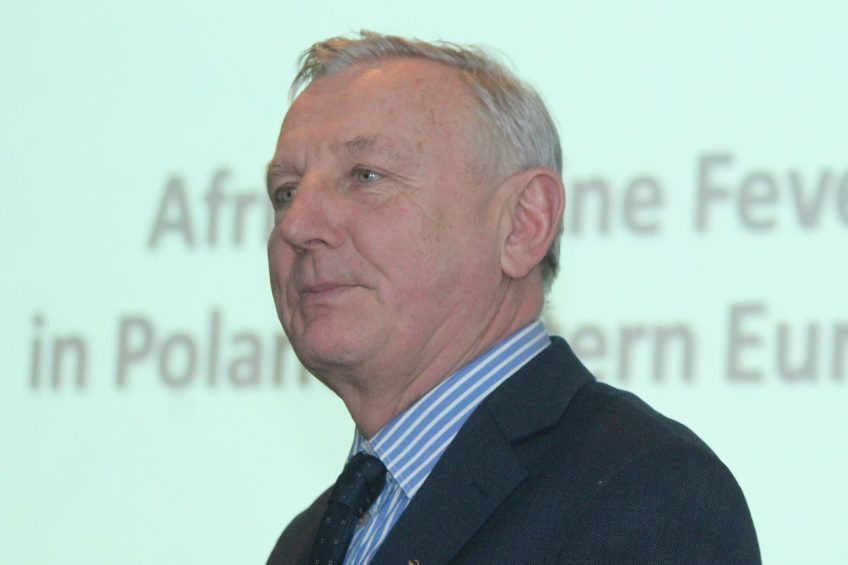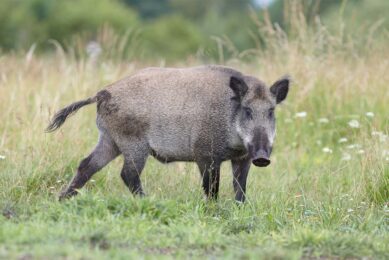INTERVIEW: ASF is to stay in Europe, says Prof Pejsak

Currently, a dead wild boar is more dangerous than a live one in Eastern Poland, as it is likely the animal will have died of African Swine Fever. These carcasses contaminated by ASFv are the basis of the ongoing spread of ASF in Poland, explains Prof Zygmunt Pejsak – and that’s where most attention should go to in order to control the virus.
Don’t have any illusions – African Swine Fever (ASF) will come to Western Europe. It may take 3 years, it may take 10 years before it is confirmed in Germany, but the message from Prof Dr Zygmunt Pejsak to swine producers all over continental Western Europe is crystal clear: there’s no way of stopping the virus circulating in the wild boar population if it is as dense as in Poland or Germany. He recently spoke at a gathering for swine professionals organised by Rabobank, in the south of the Netherlands.
|
The message from the Polish professor comes at a moment when the whole of Europe’s swine business is becoming increasingly anxious about the growing impact of the viral disease. The virus was introduced into Europe in 2007 when it was confirmed in Georgia and Azerbaijan. Via Russia, Ukraine and Belarus, wild boar populations in the European Union territories became infected – and various farms, often small but sometimes large, had to be cleaned.
For whomever doesn’t know African Swine Fever – the viral disease is not to be underestimated. The virus may not spread very fast and may require physical contact like e.g. nibbling on a carcass of a dead boar for infection. But once infected, wild boar and pigs alike most certainly die within 6 to 12 days, having developed haemorrhages and fever outwardly fairly similar to its namesake Classical Swine Fever.
“Initially in Poland we reacted in just the same way as Western European countries do about ASF,” says Prof Pejsak, who is head of the Department of Swine Diseases at the Polish National Veterinary Research Institute. “It was an exotic disease, not happening in our part of the world. Nobody had any experience with it.”
2014: ASF found in Poland for the 1st time in history
Things changed on 14 February 2014, when a local peasant in Eastern Poland noticed a dead wild boar protruding from the ice of a creek, not too far off a double fence forming the border with neighbouring Belarus. The farmer notified the authorities who eventually came and took a look at the carcass of a male wild boar. Sample analysis showed that this was the first ASF case in Poland’s history. What followed was like a whirlwind; apart from the headlines, in no-time 3 countries; Russia, Ukraine and Belarus immediately closed their borders to pigs and pork meat for sanitary reasons.
2nd ASF case found – wild boar
Only 3 days later, on 17 February, a second case surfaced, about 15km south of where the first carcass was found, this time about 2km away from the border. According to Prof Pejsak, the location of this find was very interesting. He says, “Most wild boars don’t travel that much, they stay in an area with a maximum of 5 to 7 km. So we can conclude that these animals did not belong to one group of wild boar. So a direct link between these 2 findings is unlikely.”
1st ASF found on farm
Another interesting example from 2014 happened on a small farm with only relatively few pigs and low biosecurity, Prof Pejsak explains. Pigs there appeared to have been infected when they were provided hay and straw that was collected from the fields. Some of these portions accidentally must have contained 1 or 2 bones of a dead wild boar, this could be enough to infect pigs at a farm.
Bottom line, his message is: physical borders haven’t stopped the virus from travelling. The virus will appear in places where you don’t expect it to turn up.
Control over the virus
In these early years, it appeared that Poland was able to control and contain the virus to an area in the easternmost Podlaskie province. Indeed, figures show that in the first years, the amount of cases that were found were reasonably under control when compared to later years.
2017 – Rapid increase in ASF cases
Until the first quarter of 2017, the number of new cases remained under 10 per month. Ever since, things went up rapidly, with 388 confirmed cases in the last quarter of 2017 and 511 in only the first 50 days of 2018.
The increase is reflected in the geographical spread as well. In late 2017 and early 2018, the spread extended to northern Poland, close to the border with the Russian exclave Kaliningrad as well, and also wild boars around the capital Warsaw became infected. In total, now 7 clusters of infection are identified in the country. That way, bit by bit, this way, the virus is creeping westward, Prof Pejsak states.
A matter of time before ASF hits Germany
He says, “Normally, ASF does not spread very quickly. The disease has a low contagiousness but has a high pathogenicity. In other words: it is not very easy for pigs to get infected, but when they do so, they will die. It is estimated that the virus can move about 5km per month. So this means that it is a matter of years before it reaches Germany – this could be 3, 4, 5 – maybe even 10 years. It happens slowly but steadily.”
That is, however, when the human factor is not taken into account, Prof Pejsak adds. After all, if a hunter or a truck driver throws an infected salami sandwich out of the window, then ASF can spread a lot quicker. Prof Pejsak: “In that case, ASF might be there by tomorrow.”
Wild boar are key
The presence of a wild boar population is what made the situation in Poland historically unique. Prof Pejsak says, “Earlier, the virus was found in Portugal and Spain, but there were just very few wild boar over there, the density was low. In Poland, for the first time, we had to deal with the combination of the African Swine Fever virus and a reasonably sizeable wild boar population.”
Wild boar population growth
In a historical perspective, it’s going better than ever with wild boar populations, Prof Pejsak explains – and that is in spite of hunting and African Swine Fever. He says, “In Poland alone the wild boar population has grown incredibly over the last decades. A better climate, plenty of food to eat for them (agricultural produce – mainly corn) and a change in hunting habits has led to different survival conditions. 50 years ago, a female would have 1 litter per year. In those environmental conditions, maybe 1 piglet would live. Now, a female can farrow 2 litters per year and 3 or 4 of the piglets will survive.”
Intelligent hunting
Intelligent as well as unrestricted and intensive hunting in his view is the only way to reduce the risk of the spread of ASF. He says, “EU experts have long stated that hunting wasn’t a solution for ASF spread, because it would encourage the infected wild boar to run away into non-infected zones. We have moved away from that. My plea is to do intensive, unrestricted hunting in a 50km radius around infections, so in areas where there are no ASF infections. We need to reduce the wild boar population by 20 to 30 times. This is to keep the disease risk as low as possible. I strongly underline that hunting must be ‘intelligent’, i.e. very well organised and focused on females. To organise hunting in a proper way is key.”
Infection epicentre: Electric and smell fencing
The only exception would be the zone immediately surrounding an epicentre of infection, Prof Pejsak explains: “Once a zone has been identified as having ASF cases, we want to keep the wild boar there. Unlimited shooting there would lead to an exodus. That is why, electric and smell fencing is what is required, in combination with feeding the wild boar in the epicentre of a contaminated area.”
“The most important in this all is to kill as many wild boar as possible in the wider area around the infected zone. So even if an infected wild boar would go out of the infected zone, it will break the infectious chain because there are no others to infect.”
Dealing with carcasses
On top of this, Prof Pejsak believes it is essential to consistently and decisively deal with carcasses. Once they are found, they need to be tested and disposed of. That way on one hand, a reasonable picture can be created about the spread of the disease, and on the other, infection chances are reduced to a minimum.
Advice for producers
Currently, with the 7 clusters of ASF in Poland, Prof Pejsak realises that eradicating the virus similar to what happened with rabies in foxes, appears to be an illusion. At least, if there are no new tools, like a proper oral vaccine.
Therefore, Prof Pejsak expects the virus to gradually become endemic in the European wild boar population, a situation that is seen with other viruses as well. Over time, a certain amount of animals will live in spite of being infected, which will create a situation similar to e.g. warthogs in sub-Saharan Africa which are resistant to ASF.
Stringent biosecurity
For pig producers this means that it is possible to keep their herds free from ASFv, as long as all biosecurity procedures are followed responsibly day-in, day-out. That, for now, is the main take-home message – never forget to apply stringent biosecurity, that is the advice Prof Pejsak would like to give to swine producers in Western Europe. He says, “Making sure that boots are changed using a Danish bench, not allowing vehicles to come on-farm and if they have to – take the time for proper disinfection. Just doing it for 20 seconds is not enough.”
Second author: Erik Ordelman, reporter, Boerderij
 Beheer
Beheer









 WP Admin
WP Admin  Bewerk bericht
Bewerk bericht